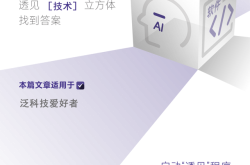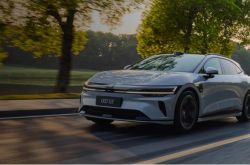Uber, Lyft, and Self-Driving: Robotaxi Spearheads Autonomous Driving Globalization
![]() 08/08 2025
08/08 2025
![]() 671
671
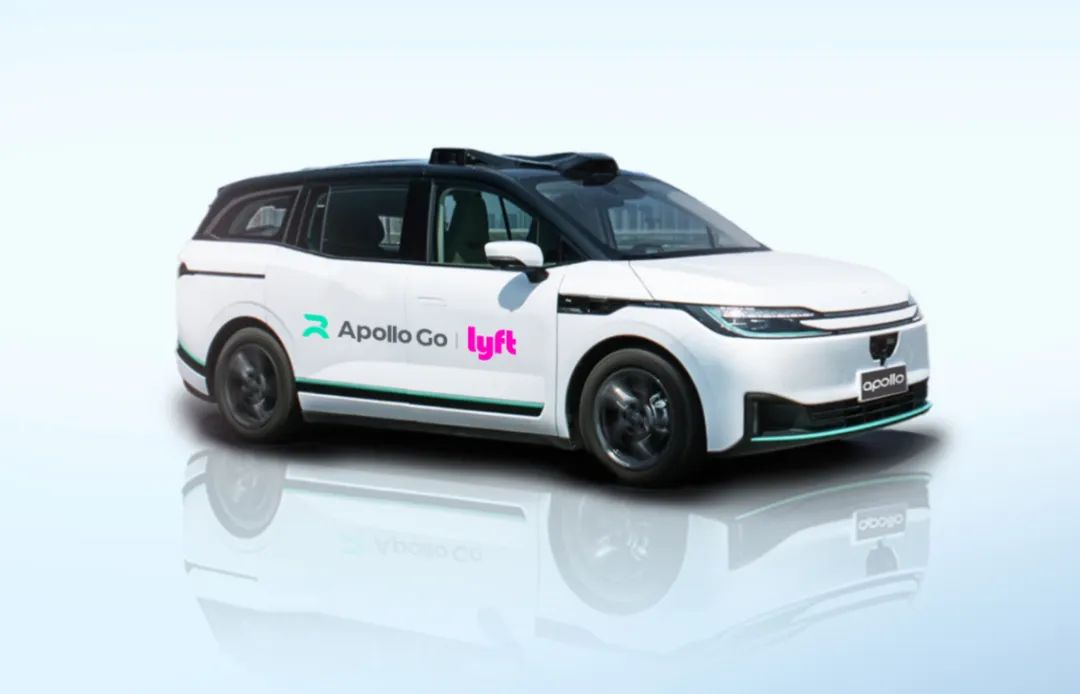
Amidst the rapid advancements in new energy, autonomous driving, artificial intelligence, and chip technology, the automotive industry is undergoing unprecedented transformations. LingTai LT introduces the "Auto Circle" column, dedicated to dissecting the latest industry developments, market trends, new product launches, technological innovations, and the market performance of major automakers. This in-depth exploration unveils the underlying business logic and market dynamics, elucidating how these shifts are reshaping the automotive landscape and influencing human travel patterns. This article, the 21st in the series, focuses on how Robotaxi represents Chinese companies in spearheading the globalization of autonomous driving.
Author|An Yu
Editor|Hu Zhanjia
Operations|Chen Jiahui
Produced by|LingTai LT (ID: LingTai_LT)
Cover image|Provided by Robotaxi
Recently, Robotaxi, China's leading autonomous driving ride-hailing platform, has announced a series of notable achievements.
At the World Artificial Intelligence Conference on July 26, 2025, Robotaxi was selected for the China AI Industry Innovation Achievement Exhibition and received a fresh batch of demonstration operation licenses for intelligent and connected vehicles in Shanghai.
On August 5, Robotaxi officially announced a strategic partnership with Lyft, aiming to deploy thousands of autonomous vehicles in the European market, marking a significant step towards large-scale deployment of autonomous vehicles. Lyft, founded in 2012 and headquartered in San Francisco, USA, is a global ride-hailing giant alongside Uber.
Following the announcement, Lyft became a "Robotaxi concept stock" overnight. On August 4, Eastern Time, Lyft's share price closed at $14.08 per share, up 3.38%. The following day, before market open, Lyft's share price surged over 2%.
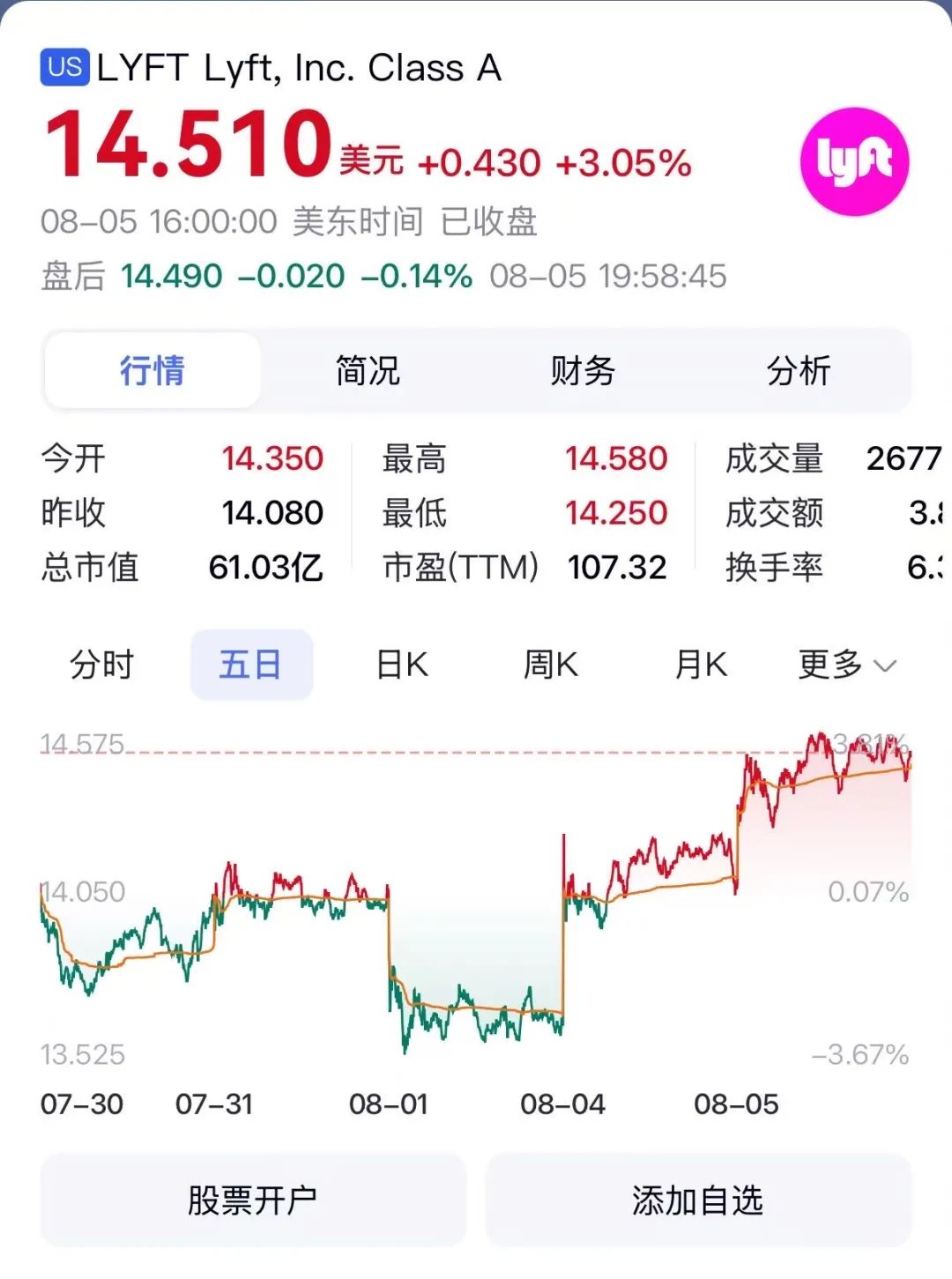
Lyft CEO David Risher expressed his enthusiasm for the partnership on social media.
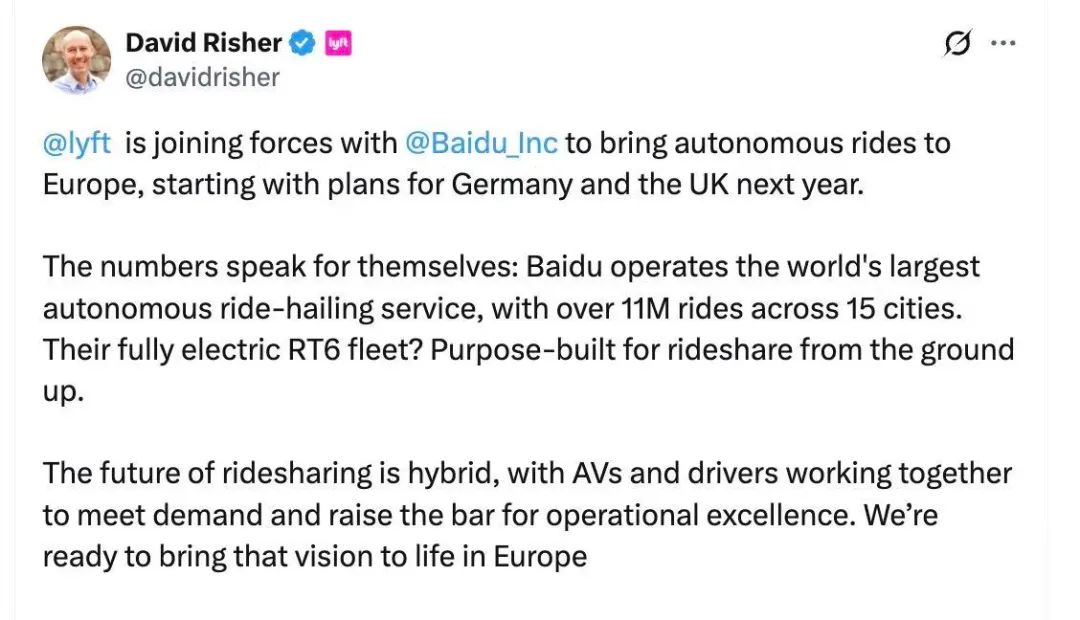
▲Image: Lyft CEO's tweet
Prior to the Lyft partnership, on July 15, Robotaxi announced a strategic collaboration with Uber to deploy thousands of autonomous vehicles across multiple global markets, pioneering large-scale deployment of autonomous vehicles.
However, Robotaxi faces considerable competition. The global autonomous driving sector is fiercely competitive. With supportive policies in the United States, companies like Tesla and Waymo are rapidly expanding their footprints and witnessing a surge in orders. As a global leader in autonomous driving, Robotaxi fiercely competes with the other two major players in the market.
If Robotaxi can receive more favorable domestic policy support, it is poised to lead Chinese autonomous driving companies in redefining the global travel landscape.
After Uber, Robotaxi Takes the Lead in Achieving Global Large-Scale Deployment
To summarize Robotaxi's development trajectory since 2025, "globalization" and "scale" are indispensable keywords.
As early as the end of March 2025, Robotaxi announced its landing in Dubai and Abu Dhabi, deploying over 1,000 fully autonomous vehicles in Dubai's urban area and collaborating to build the largest unmanned fleet in Abu Dhabi.
In mid-May, The Wall Street Journal reported that Baidu was actively expanding Robotaxi to Switzerland and Turkey, accelerating its overseas expansion. It is reported that Baidu plans to establish an entity company in Switzerland as a forward base for its autonomous driving business in Europe.
A month later, the Transport Department of the Hong Kong Special Administrative Region (China) announced that Robotaxi had been approved to conduct tests on designated road sections and time periods in Tung Chung, Hong Kong. This followed Robotaxi's expansion of its test area at the end of April.
Recently, Robotaxi has also partnered with global travel giants like Uber and Lyft, entering European markets such as Germany and the United Kingdom, as well as markets in the Middle East and Asia.
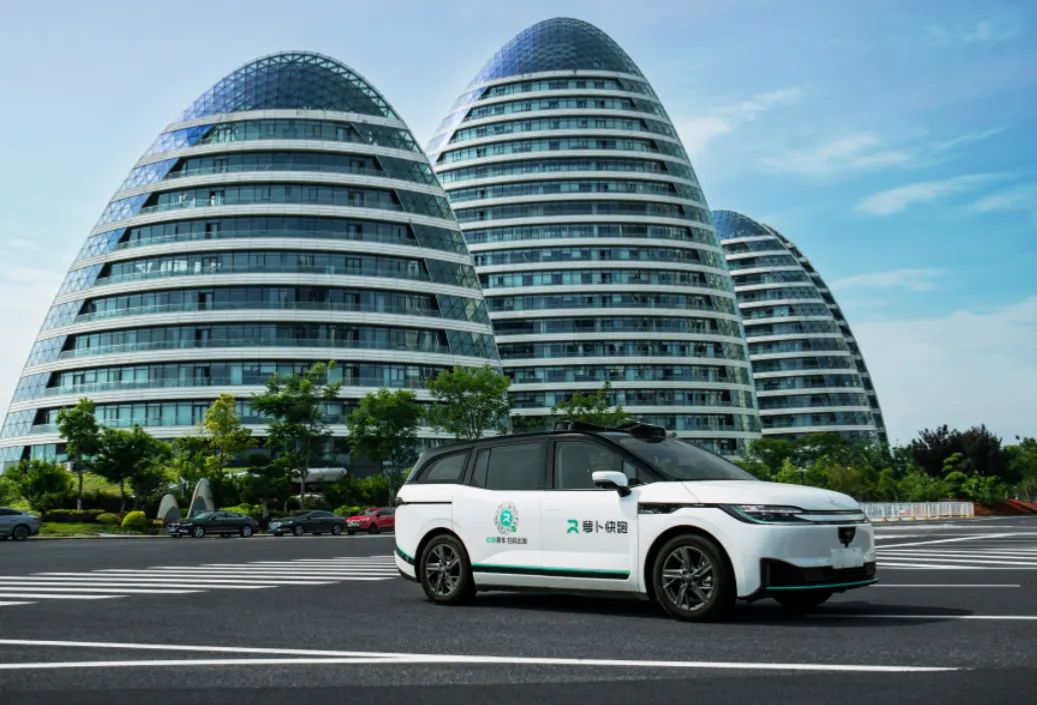
While Robotaxi leads in large-scale deployment of autonomous vehicles globally, it is not the only major player. Currently, US companies like Waymo and Tesla are also vigorously conducting trial operations of autonomous vehicles.
Comprehensive information from Tianyancha media shows that Waymo has started large-scale operations in cities such as San Francisco, Los Angeles, Phoenix, Austin, and Atlanta in the United States, with 1,500 vehicles providing over 250,000 paid trips per week. Next, Waymo plans to enter cities such as Washington and Las Vegas.
Since the trial operation began in Austin, Texas, on June 22, 2025, Tesla's Robotaxi business has actively sought to expand its scope. It is currently planning to cover more areas in Austin and apply for testing and operation in Phoenix, Arizona.
After analyzing the information, LingTai LT (ID: LingTai_LT) found that the current global autonomous vehicle market presents a competitive landscape among Robotaxi, Waymo, and Tesla. Among them, Robotaxi has taken the lead in going abroad and penetrating various regions worldwide, realizing the global large-scale deployment of driverless vehicles, undoubtedly positioning itself as an industry leader.
Autonomous Driving + Large Model: The Key to Robotaxi's Industry Leadership
Robotaxi's pioneering role in large-scale deployment of driverless vehicles and leadership in the global autonomous vehicle market is not accidental. To a large extent, it is due to its outstanding comparative advantages in technology, safety, cost, and other dimensions.
As one of the earliest companies to bet on autonomous driving technology, Baidu has over a decade of experience in this field, making Robotaxi's accumulation and understanding of autonomous driving technology far surpass that of ordinary enterprises.
For example, in choosing technical solutions, Robotaxi did not follow the traditional "pure vision + rule-based" approach but became the world's only player in "autonomous driving + large model".
At the hardware level, Robotaxi's autonomous vehicles adopt a multi-sensor strategy, equipped with LiDAR, millimeter-wave radar, cameras, and other sensors. At the software level, leveraging large model technology with strong learning capabilities, Robotaxi's autonomous driving technology is more flexible. These factors ensure that Robotaxi's autonomous driving technology offers robust safety and adaptability.
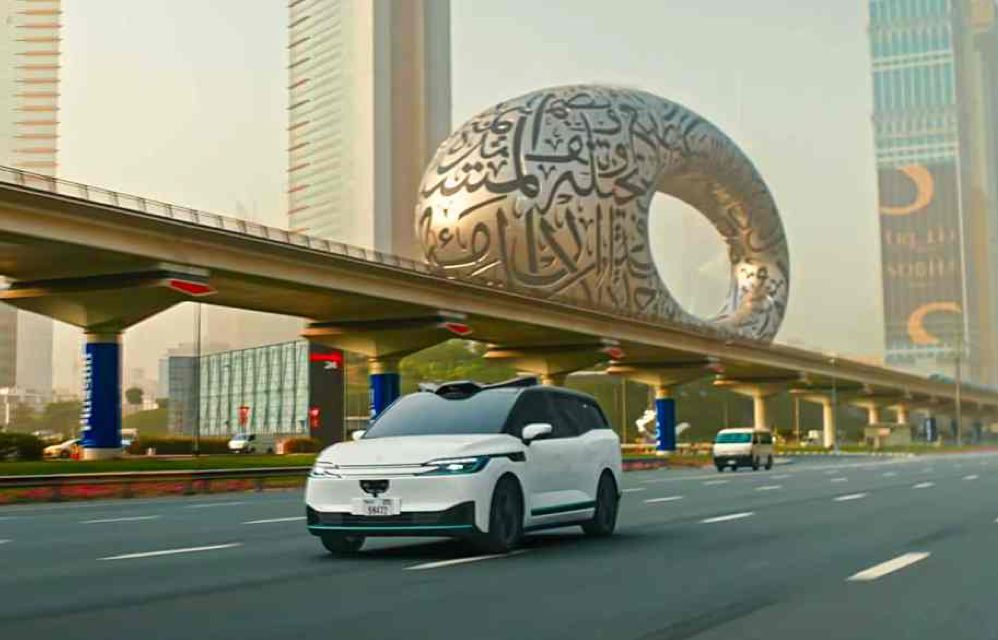
Equipped with a massive number of sensitive sensors and deeply integrated with pre-drawn high-precision maps, Robotaxi's autonomous vehicles exhibit outstanding accuracy, redundancy, and reliability, enabling them to easily navigate complex urban environments and extreme weather scenarios.
According to Tianyancha and official data, in the past two years, under complex road conditions in China, Robotaxi's actual vehicle accident rate is only 1/14 that of human drivers. Currently, Robotaxi has safely traveled over 170 million kilometers and provided over 11 million safe travel services.
Beyond safety, the large model also enables Robotaxi's autonomous driving technology to possess strong generalization learning abilities. As we know, different regions worldwide adopt varying travel policies. For instance, some drive on the right, while others drive on the left. Relying solely on rule-based algorithms would require manual coding to adjust the adaptability of autonomous driving technology, which is highly inefficient.
Conversely, leveraging the flexible generalization learning capabilities of the large model, Robotaxi can swiftly achieve city-wide complex scenario coverage globally. For example, in November 2024, Robotaxi obtained the first batch of pilot licenses for autonomous vehicles in Hong Kong and commenced road tests, quickly expanding into right-hand drive areas. The latest assessment by the Hong Kong Transport Department shows that Robotaxi performs stably in different road scenarios, with a safe driving mileage exceeding 15,000 kilometers.
Exceptional adaptability and high safety have paved the way for Robotaxi to broaden the global market. On March 25, 2025, Singapore's Deputy Prime Minister Heng Swee Keat visited Yizhuang Apollo Park and took a test ride in Robotaxi's sixth-generation driverless vehicle on Beijing's public roads during rush hour, sincerely praising, "Very good, this is the future!" and extending an invitation, "Welcome Robotaxi to Singapore."
Furthermore, Robotaxi recognizes that for cutting-edge technology to be widely adopted, market affordability for usage costs cannot be overlooked. While increasing investment in cutting-edge technology, it is also committed to reducing the cost of autonomous vehicles.
Official data reveals that compared to the previous generation of models, the cost of Robotaxi's sixth-generation vehicle has decreased by 60%, with a unit price of only $28,000, which is one-seventh of Waymo's. The operating cost has been reduced by 30%, the service cost by 80%, and the daily cost from $533 to $270.
It is worth noting that Tesla's planned Robotaxi, expected to go into mass production as early as 2026, also costs approximately $30,000. Today, Robotaxi can build an autonomous vehicle for only $28,000, indicating a strong first-mover advantage.
Outstanding technical strength, reliable safety guarantees, and lower landing costs collectively form a solid barrier for Robotaxi to spearhead the global large-scale deployment of autonomous vehicles, making it a pivotal force leading the global transformation towards intelligent travel.
Global Autonomous Driving is the General Trend, and Policy Support is Indispensable
The technology industry's "arms race" for Robotaxi is largely driven by the huge commercial value of autonomous driving technology and its potential to disrupt the global travel industry.
Data disclosed by Goldman Sachs indicates that the global Robotaxi market is expected to reach $40 billion to $45.7 billion by 2030, with a compound annual growth rate exceeding 60%.
For a technological powerhouse to maintain leadership in the global autonomous driving industry, it cannot solely rely on technology companies to continually deepen autonomous driving's underlying technology in the laboratory. Instead, it must also provide a suitable policy environment to escort these companies' cutting-edge technology.
Taking the United States as an example, autonomous driving companies like Waymo and Tesla have established their forward positions for Robotaxi services in Austin, Texas. This is primarily due to Texas's special legislation passed in 2017, allowing companies to directly test autonomous vehicles on public roads without additional approvals or drivers.
Relying on loose and suitable policies, Waymo and Tesla are "growing fiercely." Less than a month after the initial launch of Robotaxi services in Austin, Tesla's service area expanded for the first time, from 20 square miles to 42 square miles.
To maintain its competitive edge, in July 2025, Waymo announced it would expand its service coverage in Austin from 37 square miles to 90 square miles. A month later, Tesla once again expanded its Robotaxi service area in Austin, covering 80 square miles and multiple suburban areas.
Clearly, although Waymo and Tesla lag behind Robotaxi in autonomous driving technology strength and cost, these American companies have not given up. Instead, they actively leverage policy advantages to take small steps and quickly close the gap with Robotaxi.
This also provides insights for the development of autonomous driving technology in China. Besides enterprises delving into technology, the policy level should also follow up promptly to provide a conducive institutional environment for industrial development and help enterprises maintain a competitive edge.
In this regard, Wang Xianjin, member of the National Committee of the Chinese People's Political Consultative Conference, deputy director of the Academy of Transportation Sciences of the Ministry of Transport, and chief engineer, stated, "The current window period for the development of autonomous driving globally is fleeting. China's autonomous driving technology is at the international leading level. We should actively support the industry's development, further strengthen technological advantages, and achieve comprehensive leadership in technology application, policies and regulations, and industrial development."
Relevant departments can accelerate the unification process of autonomous driving testing and access standards, establish a unified national road testing rules, data access mechanism, and safety assessment system. Simultaneously, they should promote the mutual recognition of testing qualifications across regions, reduce resource waste caused by repeated testing by enterprises, create a more stable and predictable policy environment, and propel China's autonomous driving industry towards a new stage of high-quality development.
Written at the end
After more than a decade of patient dormancy, technology companies, with Robotaxi at the forefront, have finally emerged as leaders in the global autonomous driving industry.
Nevertheless, American companies such as Waymo and Tesla have not been idle. They have actively leveraged policy advantages to accelerate their growth, striving to keep pace with Robotaxi.
In this context, for China to establish a significant presence in autonomous driving technology, it is imperative to provide more targeted policy and legislative support to autonomous driving companies, particularly those represented by Robotaxi, and to establish a robust institutional support system.
It is widely believed that with ongoing policy efforts, Robotaxi will reinforce its leading position in the global autonomous driving competition, thereby further solidifying China's strategic role in leading the global technology race in intelligent transportation.


